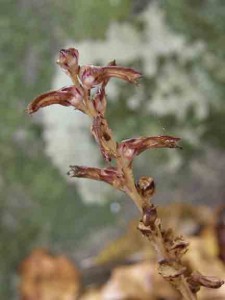A walk in the rain
Originally published November 13, 2008

Photo by Dave Otto. The purplish flowers of the leafless, parasitic beech-drops can be found now in the forests beneath beech trees.
By Ken Moore
Dave Otto, organizer of the monthly Friends of Bolin Creek walks, and I had considered rescheduling due to predicted rain. Impulsively, I suggested we proceed as planned and enjoy exploring nature in nature’s conditions.
Some hardy individuals showed up at Wilson Park appropriately attired and we charged off to the Adams Tract trailhead kiosk where we borrowed one of the laminated trail map/tree description guides, a nice amenity provided for trail walkers.
Once in the woods our pace frequently slowed to a standstill as various ones paused to take “closer looks†or pose some kind of “I wonder†idea.
Noticeable as we walked up through the mixed forest of pines hardwoods was an extensive shrub cover of invasive exotic Chinese privet, Ligustrum sinense, and two species of Russian olive, Eleagnus umbellata and evergreen E. pungens, threaded together at ground level with Japanese honeysuckle, Lonicera sempervirens, and high above with the tree strangling Chinese wisteria, Wisteria sinensis. We all expressed willingness to help out whenever an organized workday is scheduled to remove these undesirable exotics.
Sadly missing from our group on this wet day were young people. We see so much more when led by their eager minds and alert eyes. So we challenged ourselves to see with the eyes of children Our eyes were sharpened by someone pointing to clusters of pale brownish-yellow and purplish pencil-thin stems, six to 12 inches tall, rising from the leaf litter beneath some of the beech trees. Beech-drops,
Epifagus virginiana, are blooming now. The barely open purplish flowers at the top are sterile, but the closed (cleistogamous) flowers lower down are fertile and will produce seed. This little leafless plant is parasitic on the roots of beech trees and it doesn’t seem to harm the giant trees above. Some of the beech drops were far away from the beech trunks, emphasizing to us how far reaching are the surface roots of trees.
Though stopping frequently to admire the fall colors and big trees, our attention kept returning to the forest floor. The mossy patches were interrupted with evergreen leaves and lush green rosettes scattered about as if carefully planted in miniature gardens. A special discovery was a mossy ledge covered with the trailing evergreen partridge berry, Mitchella repens, with a single brilliant-red berry still hanging on. We thought back to the spring when the beginning of that little berry was the base of two small, fused-at-the-base, white trumpet-shaped flowers.
The rainy morning passed quickly and we thanked one another for showing up to share the woods ramble. Personally, I’m looking forward to the winter months. The forest is very special then; without all those leaves, one can really see and study the forest landscape.
Note: In some future Flora columns, I will announce occasional woods walks. You will be welcome to join me; and if you don’t have a kid of your own to bring along, borrow one from a friend. We’ll discover a lot more with the young ones leading us.


Comments are closed.